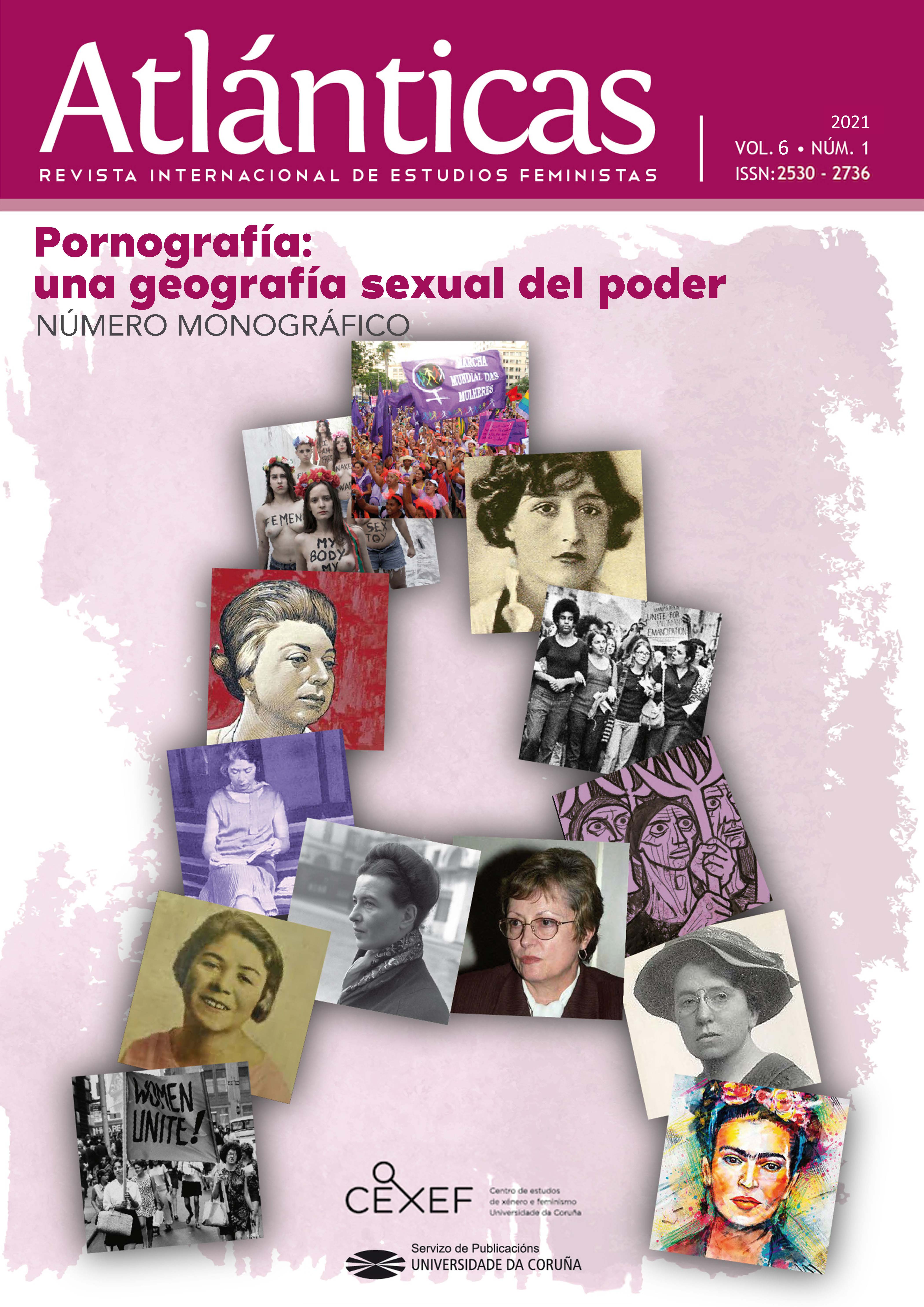Inegalitarian Pornography: Revisiting harm-based arguments
Main Article Content
Abstract
Pornography is a space of contention within the feminist circles. This article focuses on one of the arguments of the anti-pornography movement within feminism regarding the direct and indirect harms that pornography allegedly causes. Direct harm involves those who participate in the production of pornography; while indirect harm includes violence against women; gender inequality, and silencing. The article has an ethical-normative approach as it explains whether the anti-pornography argument is sound enough as well as its capacity to raise counter-objections. The analysis is based on two epistemological principles: firstly, that the gender cultural order is the social sphere where expressions of subordination are reproduced to the detriment of women; and, secondly, that inegalitarian pornography contributes to gender inequality by eroticising relations of violence and subordination, in contrast to other forms of gender representation in which inequality is not depicted in a sexualised way.
Keywords:
Downloads
Article Details
References
Attwood, F. (2011). The Paradigm Shift: Pornography Research, Sexualization and Extreme Images. Sociology Compass, 5(1), 13-22. doi:10.1111/j.1751-9020.2010.00356.x
Attwood, F., & Smith, C. (2014). Porn Studies: An introduction. Porn Studies, 1(1-2), 1-6. doi:10.1080/23268743.2014.887308
Austin, J. L. (1975). How to do things with words (2nd ed.). Oxford: Clarendon Press.
Bridges, A. J., Wosnitzer, R., Scharrer, E., Sun, C., & Liberman, R. (2010). Aggression and sexual behavior in best-selling pornography videos: a content analysis update. Violence Against Women, 16(10), 1065-1085. doi:10.1177/1077801210382866
Chaparro, A. (2018). Subordinación y silencio: sobre la libertad de expresión y la igualdad de las mujeres. In T. González Luna & J. Rodríguez Zepeda (Eds.), El prejuicio y la palabra: los derechos a la libre expresión y a la no discriminación en contraste (pp. 283-308). México: SEGOB / Cátedra UNESCO / RINDIS / CONAPRED / IIJ UNAM.
Crenshaw, K. W. (2010). Close Encounters of Three Kinds: On Teaching Dominance Feminism and intersectionality. Tulsa Law Review, 46(1), 151-189.
Cyber Civil Rights Initiative. (2013). End Revenge Porn. Retrieved from https://www.cybercivilrights.org/wp-content/uploads/2014/12/RPStatistics.pdf
Dworkin, A. (1987). Intercourse. New York: Free Press.
Dworkin, A. (1989). Pornography: men possessing women. New York: E. P. Dutton.
Dworkin, A., & MacKinnon, C. A. (1988). Pornography and civil rights: a new day for women's equality. Minneapolis, Minn.: Organizing Against Pornography.
Eaton, A. W. (2007). A sensible antiporn feminism. Ethics, 117(4), 674-715. doi:10.1086/519226
Five Guys. (2016). The Porn Monopoly. Retrieved from https://medium.com/five-guys-facts/8-19-16-davis-ce6771141589
Griffiths, M. (2012). Internet sex addiction: A review of empirical research. Addiction Research and Theory, 20(2), 14. doi:10.3109/16066359.2011.588351
Hornsby, J., & Langton, R. (1998). Free speech and illocution. Legal Theory, 4(1), 21-37. doi:10.1017/S1352325200000902
Hunt, L. e. (1993). The Invention of Pornography, 1500--1800: Obscenity and the Origins of Modernity. New York: Zone Books.
Jeffreys, S. (2009). The industrial vagina. The political economy of the global sex trade. London: Routledge.
Kipnis, L. (1996). Bound and gagged: Pornography and the Politics of Fantasy in America. New York: Grove Press.
Klein, M. (2006). Pornography. In P. Lehman (Ed.), Pornography: Film and Culture (pp. 244-258). New Brunswick: Rutgers University Press.
Langton, R. (1993). Speech Acts and Unspeakable Acts. Philosophy & Public Affairs, 22(4), 293-330.
Langton, R. (2009). Sexual Solipsism. Philosophical Essays on Pornography and Objectification. Oxford: Oxford University Press.
MacKinnon, C. (1987). Feminism Unmodified. Discourses on Life and Law. Cambridge, Mass: Harvard University Press.
MacKinnon, C. (1989). Toward a Feminist Theory of the State. Cambridge, Mass.: Harvard University Press.
Malamuth, N., & Check, J. V. P. (1981). The effects of media exposure on acceptance of violence against women: A field experiment Journal of Research in Personality 15, 436-446.
Manne, K. (2018). Down Girl. The Logic of Misogyny. New York: Oxford University Press.
May, L. (1998). Masculinity and Morality. Ithaca: Cornell University Press.
Mestre-Bach, G., Blycker, G., & Potenza, M. N. (2020). Pornography use in the setting of the COVID-19 pandemic. Journal of Behavioral Addictions, 1-3. doi:10.1556/2006.2020.00015
Nussbaum, M. C. (1999). Sex and Social Justice. New York: Oxford University Press.
Paglia, C. (1996). Sex, Art, and American Culture. New York: Vintage Books.
Palys, T. S. (1986). Testing the common wisdom: The social content of video pornography Canadian Psychology/Psychologie canadienne, 27(1), 22-35. doi:10.1037/h0079859
PornHub Insights. (2019). The 2019 Year in Review. Retrieved from https://www.pornhub.com/insights/2019-year-in-review
Prynosky, C., & Prynosky, S. (2017). Big Mouth. In J. Moser (Ed.), ThePornscape (Vol. 1).
Rubin, G. (1984). Thinking Sex: Notes for a Radical Theory of the Politics of Sexuality. In C. Vance (Ed.), Pleasure and Danger (pp. 143-178). Boston & London: Routledge & Kegan, Paul.
Russell, D. (1998). Dangerous Relationships: Pornography, Misogyny, Rape Sage.
Satz, D. (2010). Why Some Things Should Not Be for Sale: The Limits of Markets. New York: Oxford University Press.
Serret, E. (2011). Hacia una redefinición de las identidades de género. GénEros, 9(2), 71-97.
Stanger, M. (2016). Female porn producers aren't just making great porn, they're keeping women safe. Retrieved from https://www.revelist.com/dating/women-owned-porn-companies/692
Talvacchia, B. (2010). Pornography. In A. Grafton, G. W. Most, & S. Settis (Eds.), The Classical Tradition (pp. 767-771). Cambridge: Massachusetts: Harvard University Press.
Tarrant, S. (2016). The Pornography Industry. What Everyone Needs to Know. New York: Oxford University Press.
Velasco, A., & Gil, V. (2016). La adicción a la pornografía: causas y consecuencias. [Pornography addiction: causes and consequences]. Drugs and Addictive Behavior, 2(1), 9.
Voros, F. (2009). The invention of addiction to pornography. Sexologies, 18, 4. doi:10.1016/j.sexol.2009.09.008.

